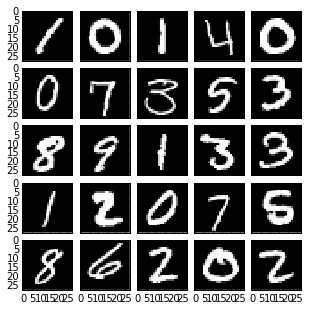In the first part of this series, I just want to get a feel for the data: visualize it and do some preliminary analysis, as if I were not familiar with the problem at all. I'll be working in an IPython notebook. If you want to follow along, I uploaded it to Github.
The data
The data consist of about 40000 digitized handwritten numerals $\in$ [0, 9]. Each numeral was digitized on a 28x28 pixel grid. These grids have been flattened into rows of 784 pixles and stacked together into a 2D array that looks like this:Each pixel has an intensity value $\in$ [1, 256]. Here's what the raw data array looks like if we just plot it:
Each row can be reconstructed into a 28x28 array. Here are some examples of random reshaped rows:
The information
Eventually we'll want to train a classifier with these digits, and will want to figure out which features (pixels) are important, and which ones aren't. There are plenty of ways to do that automatically, but it's also straightforward to poke at the data a bit and figure it out ahead of time. First, let's make sure we have the same number of examples for each numeral. The raw data array actually has a prepended "label" column that I didn't mention above, which is just the numeral index, 0-9. We can use this to make a histogram:where we see that there are about 4000 examples of each numeral.
Next, let's look at what range of intensities we have. Making a histogram of all of the intensities for the entire data set, we see the following:
where it's clear that the data mostly consist of black and white pixels, and not much in between. This gives us a hint that we could binarize the data set without losing much information. It also might mean that there's been some pre-processing done on the data set.
How much does each numeral change throughout the data set? We can get some intuition by grouping examples of each numeral and then plotting their means and variances.
Means of each numeral
Variances of each numeral
We expect variance to correlate well to information, so these images show that most of the information is clustered in a blob near the center, which isn't too surprising. We could probably throw away a bunch of the outer pixels without too much trouble. Let's quantify that.
Suppose we order these pixels by variance (descending) and plot the cumulative variance by pixel. That is, show how adding the next largest variance increases the total variance. That gives us an idea of how many pixels we need to capture most of the variance, which we can expect to be related to information content.
The green line is set at 90% of the total variance, which intersects the cumulative variance at about 290 pixels. So through this exercise we've learned that we can throw away almost 2/3 of the pixels and still capture about 90% of the information, which will be useful when we start training a classfier.










what type classifier are you going to use? i've seen convolutional neural networks do extremely well on this dataset, but they're complex. is there a worse quality, easier to implement alternative?
ReplyDeleteHaving played around with it a bit now, I can tell you that this turns out to be a pretty easy problem. The numerals are centered and noise-free. Support vector classifiers have about 96-98% accuracy, and even a logistic classifier that keeps less than half of the pixels has F1 scores around 0.85.
DeleteThis comment has been removed by the author.
ReplyDeleteis it a set of binary SVM classifiers (1 vs not 1, 2 vs not 2, etc) which are doing this? i'm actually really unfamiliar with how to do >binary classification without more involved methods. for logistic, you must be using multinomial logistic regression?
ReplyDeleteThe SVM is this one:
Deletehttp://scikit-learn.org/stable/modules/svm.html
It assumes the classes are mutually exclusive and exhaustive, and draws linear decision boundaries (hyperplane segments?) by thresholding. However, validation of the classifier is often done as one-vs-all.
The logistic classifier is this one:
http://scikit-learn.org/stable/modules/generated/sklearn.linear_model.LogisticRegression.html
using a linear (non-multinomial) kernel. Again, we draw hyperplane segments, which allows us to capture the complexity of the problem.
good day, your internet site is cheap. I do many thanks for succeed data science from scratch
ReplyDelete